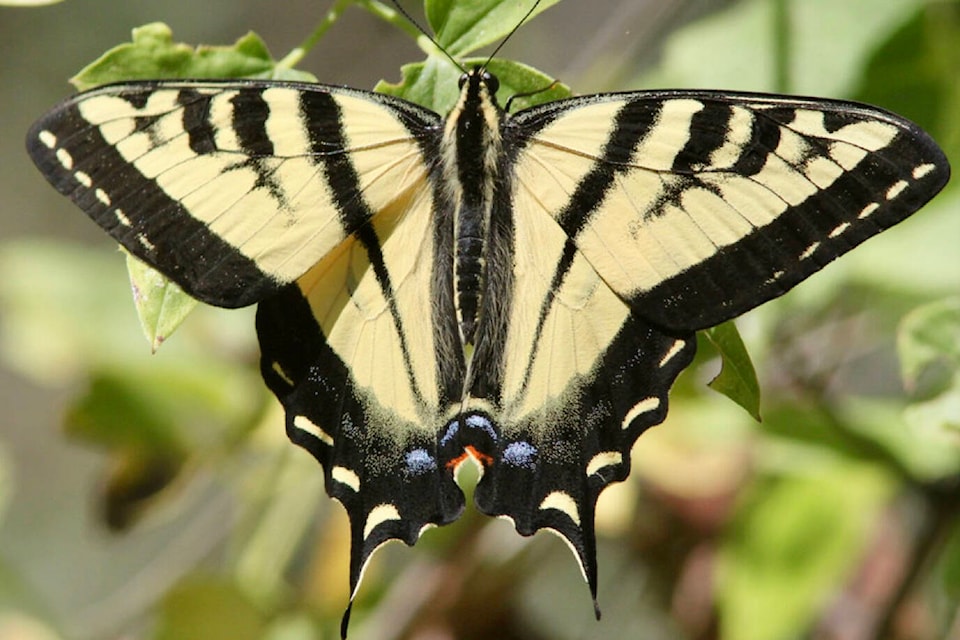Roseanne Van Ee
Get Outdoors
Watch for butterflies on warm, sunny days.
They are some of the most delightfully coloured signs of spring. Some people say butterflies are like flying flowers.
These important pollinators live in almost every habitat from wetlands and bogs, to woodlands and forests, grasslands and meadows, and even deserts and mountains. Butterflies flow through four different interesting metamorphic stages from egg, to caterpillar (larvae), to chrysalis (pupae) and finally adult butterfly. Different species have different timelines to these stages. Some species can remain dormant in their pupal or egg stages to survive winters while other butterflies migrate.
Female butterflies lay eggs on specific food plants on which their caterpillar larvae will feed. Some species lay eggs singly, others in batches. Many females produce between one hundred to two hundred eggs.
Then, in their larval caterpillar stage they grow spending practically all of their time searching for and eating plant leaves.
Many species have long caterpillar life stages. Some are especially lovely and interesting. Many caterpillars defend themselves by camouflaging or freezing to resemble sticks or branches.
Some rear up waving their front ends with snake-like eyespots. Other caterpillars resemble bird droppings.
And some caterpillars have hairs and bristles for protection while others form dense aggregations. Caterpillars are most baby birds first foods, so please don’t poison them!Once fully developed, the caterpillar pupates into a chrysalis. When metamorphosis is complete, the pupal skin splits, the adult climbs out, and after its wings have expanded and dried, it flies off as a butterfly. Butterflies in their adult stage can live from a week to nearly a year depending on the species.
Butterflies suck up flower nectar through their elongated tubular proboscis mouthpart that can be coiled up when not in use and expanded when needed to feed by sucking or sipping. Flower nectar provides sugars for energy. Butterflies don’t carry as much pollen load as bees, but they can carry pollen over greater distances. Many species maintain territories and actively chase other species or individuals that may stray into them. Butterflies also sip water, salty liquids and dissolved minerals from wet sand or dirt which are vital for reproduction. Occasionally butterflies land on people, attracted to the salt in human sweat.
Butterfly wings are covered in minute irreplaceable scales that create the wings’ vibrant colours and markings. These scales can easily rub off. So never pick up a butterfly by its delicate wings. Butterflies can only fly when their body temperature is above 27 °C. When it is cool, they expose their wings to the sunlight to heat themselves up. Basking is common in the cooler summer morning hours. Most early spring and alpine species have dark wings to help gather more heat. If their body temperature reaches 40 °C, they can position themselves with folded wings edgewise to the sun.
When resting, butterflies usually fold up their four wings holding them up above their bodies displaying their cryptic-colour wing undersides to safely camouflage. Butterflies are diurnal with club-tipped antennas with sensory receptors that detect odours and feel wind. (Their subtle coloured moth cousins are nocturnal with feathery antennas.) Taste receptors are located on their feet. Butterflies have good colour vision and most are sensitive to ultraviolet light. Some butterflies can hear and some species make clicking sounds.
There are over 18,000 species worldwide with about 750 different butterflies in North America. The trick to identifying butterflies is to learn the basic different groups by their size, wing shape, colour and markings. The family names often resemble their characteristics; Swallow Tails, Whites, Sulphurs, Coppers, Blues, Crescents, Checkerspots, Anglewings, Hairstreaks, Skippers and more. Get to know some of the common butterflies in your area and how to attract them to your yard. If you’d like to help endangered species, this is a great place to start!
Declining butterfly populations is consistent with the rapidly decreasing insect populations around the world right now. Many butterfly habitats are being destroyed by urban and industrial development. And butterflies, their caterpillars, and food sources are being poisoned with insecticides, herbicides, pesticides, etc.
Their natural predators include ants, spiders, wasps and birds.
Our outstanding local entomologist, Ward Strong says, “The main thing about butterflies I’ve noticed over the last 25 years is the huge decline in both numbers and species. We still commonly see swallowtails, mourning cloaks, and blues, but rarely find checkerspots, coppers, anglewings, fritillaries, etc and more.” How sad! But we can reverse this trend if we want. You can help them by simply establishing habitat in your own backyard!
Attract our native butterflies into your yard by growing the appropriate native plants for their food and shelter. Certain plants have evolved and co-exist with our native butterflies. The Allan Brooks Nature Centre has a handy checklist of North Okanagan butterflies with their habitats and appearance months. They also have Milkweed seeds vital for Monarchs. Join the Butterflies in My Backyard (BIMBY) project at davidsuzuki.org/bimby
And we are so fortunate to have a marvellously useful field guide, Butterflies of British Columbia, by award-winning science writer and naturalist John Acorn. It includes very handy quick-at-a-glance references to B.C.’s butterfly groups with spectacular illustrations, dazzling colour photos, distinguishing butterfly features, geographic ranges, behaviour and preferred food plants. Our library has copies to help get you started.
Some of our common local butterflies:
•Mourning Cloaks - often first seen spring butterflies
•Western Spring Azure - our first “blue” to flutter around
•Pine White
•Western Tiger Swallowtail - often mistaken for Monarchs. Swallowtails have yellow and black wings with a “tail” sticking out from each wing.
•Painted Lady - migrate over long distances
•Red Admiral
•Clouded Sulphur - common yellow butterflies - maybe the origin of “butterfly”
•Desert Orange Tip - chrysalis for several years
READ MORE:
READ MORE:
newsroom@vernonmorningstar.com
Like us on and follow us on .



